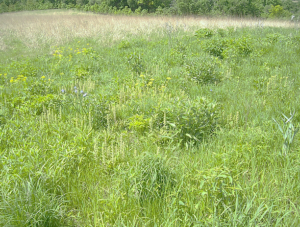Nature’s Tool Box

It’s one of those rare August days with low humidity and a cool breeze blowing from the north. I’m driving up a narrow, paved driveway lined on both sides with Colorado blue spruce. After a considerable distance, the rows of spruce end, giving way to an expansive yard. I park at the crest of a hill near a three-car garage, grab my notebook and step out of the car. The vista is commanding: a series of undulating hills covered in big bluestem grass. The cloud-filtered sun pulls out the purple hue of the grass flowers and the wind gives it life as synchronized waves dance over the hills. Purple mountain majesty, I think.
“Hello.” I turn and greet the landowner. “I see you found our place okay.”
“Yes,” I say, “what lovely weather and what a beautiful view.”
I watch the positive expression melt from his face. He turns away, now facing the fields of big bluestem grass, makes a broad sweeping gesture with his right arm and says: “We want all this tall grass to be shorter and filled with colorful flowers.”
When it comes to planting or reconstructing a prairie, it’s an elusive event when landowner expectations match with the results. Too much grass is a common perceived problem. To avoid dense grass, prairies are often planted with little grass and quickly end up being dominated with Canada goldenrod or some other fast-moving rhizomatous forb (flower) species.
To deal with an “unbalanced” prairie, practitioners have developed a variety of methods to manipulate diversity into plant communities. Essentially, all the methods create a disturbance to weaken the dominant species followed by inter-seeding species that are not currently represented. We want whatever we do to be sustainable and to continue to become more diverse with the passage of time.
I have always been most interested in how plant species interact with each other. How plant A keeps plant B in balance, freeing up niche space for plant species X, Y and Z.
Wood betony (Pedicularis Canadensis) is a powerful tool from nature’s tool box for creating more plant diversity. For background on wood betony, see blog post “Pathway to Diversity” July 4, 2017. I have struggled for years to establish wood betony in super-thick stands of planted warm-season grasses such as Indian grass and big bluestem. However, I now have a system that I have used over several years and in dozens of plots that has been 100% successful in establishing wood betony (from seed I collected) in dense stands of tall warm-season grasses and rhizomatous forbs such as Canada goldenrod.
Here’s what to do: Collect seed or buy fresh seed. (Note: I have had very poor results with purchased seed.) Shortly after the seed is dry and falls freely from the dried flower stalks, I sow it into a plot of dense grass and mark each corner with a steel stake or other non-flammable material. Plot size is typically 5-feet wide by 10-feet long. The amount of seed I use is enough to fill the fleshy part of my cupped palm but not deep enough to spill out of the gaps between my fingers.
Burn the plot the following fall, winter or very early spring. Mark the top of the stakes with flagging tape so it can be found when the grass is tall. Mow the plot to 4 inches when the grass is 8 inches, several times during the growing season after the burn.
I keep the plot narrow so I can easily mow it with my brush or clearing saw without stepping on the seedlings. The seedlings will die if the grass is allowed to overtop them blocking all sunlight. The seedling density is important. Wood betony seedlings need to be cluster planted in dense grasses to be successful. All these little seedlings quickly latch on to the grass roots and working together weaken the grass very quickly. You will notice that mowing frequency will really slow down as the summer wears on and the betony plants increase in size.
That’s it. No other follow up care is needed after the first growing season. The betony plants will keep the grass short and expand out from the original plot over time. Usually, after a couple of growing seasons, I start to introduce new species into the plots. Species I have successfully introduced into wood betony plots include blue-eyed grass, partridge pea, cream and stiff gentian, shooting star, lead plant, prairie coreopsis, white and purple prairie clover and golden Alexander. I don’t know all the species wood betony will or will not parasitize.
In some of my older plots, it appears that the wood betony weakens in the center (maybe from self-competition or severely weakened host plants) and forb species of all types quickly take advantage of the opportunity. In the spring, it looks like a donut of blooming betony plants with the “hole” filled with an assortment of other forbs. Outside of the donut ring is thick grass.
When introducing wood betony, choose your plots carefully. Avoid areas that have invasive species present that may be released from the thick grass completion by the wood betony. I have seen non-native hawkweeds quickly utilize the open space produced by wood betony.
One of my favorite early spring rituals is to inspect wood betony patches for queen bumble bees. The queen bees just love betony. It’s an important food source for the queens as they rebuild their colonies after a long hibernation.
So, if you have too much grass or weedy goldenrod in your prairie, call on nature’s tool box and give wood betony a try. Granted, due to seed availability, it’s a slow-go approach, but it’s sustainable and very low maintenance.
It’s nature’s way.
Originally published in Environmental Returns.


